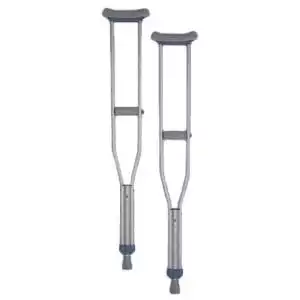Crutches for Sale
Maximize Your Independence While You Heal
Lower limb injuries can be frustrating. Even a minor sprain can temporarily take you off your feet for several days, seriously limiting your freedom and impeding your ability to handle daily tasks. While rest is recommended, life often demands that patients find a way to accommodate their injuries while going about everyday life. With a number of crutches for sale to choose from, you can find the support you need to attend work or home life without further injury.
When to Use Walking Aids
Despite the fact that crutches are the simplest way to keep weight off your lower limbs, they can only do so when used correctly. If you’re not sure whether or not crutches are the correct choice, speak with your doctor. He or she knows your abilities, strength, and injuries best, and can work with you to decide if crutches are the best choice.
Crutches work best for patients with a single-leg injury like a sprain, break, strain, ligament tear, tendon tear, or a surgical recovery site. Patients who suffer from certain neuromuscular conditions may find that crutches with arm braces are a helpful way to gain extra support when walking, too.
Safety Precautions for Crutches
You can use your crutches whether you’re wearing a cast or just a brace, but you must be absolutely sure that you won’t accidentally put weight on the injury until advised. As most crutches tuck up underneath the arm or wrap around the forearm, using crutches will require at least some upper body, hand, arm, and shoulder strength.
Patients with arthritis or degeneration in these areas may need to seek a different solution.
Sizing Guidelines for Crutches
Sizing crutches to your height and weight is extremely important. The crutch handle itself must reach a certain point on your body in order for ideal distribution of weight. If your crutches are too small or too large, you may become unstable and injure yourself further. Ill-fitted crutches can also produce pressure sores and a great deal of discomfort. Here is a brief guide on how to measure for different types of crutches for sale.
1. Axillary Crutches
This is the most common and basic crutch for temporary injuries and in-hospital use. An axillary crutch has a straight, padded top that tucks up under the armpit. It tapers down into a single-legged foot and allows you to effectively walk without using your injured leg.
How to Measure
To measure for axillary crutches, measure from your armpit to the floor. Then, allow your arm to rest at your side. Measure from the middle of your palm to your armpit. These measurements will give you the info you need to find the right size.
2. Forearm Crutches
Forearm crutches are very similar to axillary crutches but make contact with the forearms instead of the armpit. This can improve stability and comfort for some patients.
How to Measure
Utilize all of the measuring details for axillary crutches to start. Then, also measure the width and length of your forearm.
3. Platform Crutches
For patients who struggle with stability, platform crutches may improve that stability and maximize comfort in long-term use. Rather than simply sitting around the forearm, this crutch style wraps around the forearm at a 90-degree angle.
How to Measure
To measure for platform crutches, use all of the previous measuring strategies and then bend the elbow at 90 degrees. Measure the distance between the floor and your elbow.
Need Crutches? Visit Burt’s Pharmacy
Struggling to get around due to a recent injury? Come into Burt’s Pharmacy for one-on-one crutch selection guidance. We’ll help you measure and pick out a pair of crutches from our collection of crutches for sale that are uniquely suited to your height, weight, and injury type for maximum comfort. If you need adjustments, the pharmacy team can adjust your new crutches before you leave the store.
Call Burt’s Pharmacy today to schedule a consultation or to ask whether crutches for sale are right for you.
Showing the single result
-
View Product
Crutches #1

 info@burtsrx.com
info@burtsrx.com
